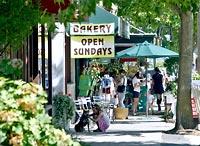Madison Park pricey, viewed as worth it

Madison Park has the buzz of city life and the quiet of country life.
The beauty of the Seattle neighborhood — bordered by Lake Washington to the east, Union Bay to the north, and the Washington Park Arboretum to the west — attracts residents who know it's pricey.
"It's expensive because it's so fabulous," resident Shirley Wilson said.
Many people cite good times at the low-end taverns on East Madison Street as their introduction to the neighborhood.
Wilson moved to the neighborhood with friends in the '60s when she was right out of college.
"Back then The Attic was really quite seedy," she said, but she loved it.
Katie Wright, 22, moved to Madison Park a year ago for the greenery of the neighborhood and the hardwood floors in her apartment. She regularly goes out to the Cactus restaurant and the Red Onion tavern.
Meredith Erickson, a real-estate agent in the area for 20 years, agrees.
"Many people start in rentals and like the neighborhood enough that they never quite leave," Erickson said.
It is still possible to find reasonable rents in the complexes along the lakeshore north of the village, but buying a first home is becoming more difficult.
Bargains are in the high $500,000s. Bungalows average $700,000, and the larger homes in the Washington Park area average $2.5 million.
Ten years ago, Karl Crabs found a Craftsman a couple of blocks from the water. It needed repair, but Crabs is a builder.
"We did enough to make sure it wouldn't collapse, and the rest was cosmetic," he said.
Now the Crabses have two boys, and 1,000 square feet isn't enough space. They looked to move within the neighborhood, "even placed offers on a few places, but prices are sky high."
He loves the house, but it was built in 1919 as a getaway cottage. It has no foundation. Remodeling isn't realistic. They are tearing down and rebuilding.
Because of the pattern of development, the neighborhood has quite a few older cottages.
In the 1860s, Judge John McGilvra bought 420 acres along the lake. He built an estate and Madison Street back to downtown. In the 1880s, he set aside 24 acres for Madison Park and sold much of his remaining land with the stipulation that only cottages could be built.
Crabs and his family looked at houses off the water but "even six to eight blocks away, it's out of the action." He prefers the liveliness, even if crowds of beachgoers do fill up parking on the streets.
Wilson finds the flood of people appealing.
"They are having a great time here," she said. "Why wouldn't you want them?"
When Wilson arrived there wasn't much beyond Bert's Red Apple grocery and the hardware store.
"Now there is enough [that] you don't have to leave the village if you don't want," she said.
Most do leave for work.
"Lots of people work downtown or in the University District, so the commute is all interior streets — no freeway," Erickson said.
The neighborhood doesn't have much ethnic diversity, Wilson said, but it is "someplace people stay."
"Families have multiple generations close, and that is unusual these days," she said.
This Seattle neighborhood — close to downtown, the University District and Capitol Hill — attracts residents who expect to pay a lot to live there.
Population: 19,109 (2004 est.)
White: 15,808; 82.7 percent
Black: 1,716; 9.0 percent
American Indian or Alaska Native: 62; 0.3 percent
Asian: 763; 4.0 percent
Hispanic: 529; 2.8 percent
(all ethnicities)
Other: 760; 4.0 percent
(some other race/two or more races)
Housing
Total housing units: 9,799 (2004 est.)
Owner occupied: 5,464; 55.8 percent
Renter occupied: 3,979; 40.6 percent
Shopping
Madison Park commercial center, with more than 60 neighborhood businesses, runs east from Lake Washington Boulevard to the foot of East Madison Street facing Lake Washington.
Parks
Madison Park Beach, East Madison and East Howe streets.
Seattle Times researcher Miyoko Wolf